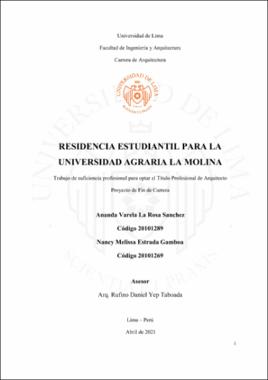Residencia estudiantil para la Universidad Agraria La Molina
Abstract
La residencia universitaria para la Universidad Agraria La Molina es un proyecto que se centra en mantener la conexión que tiene el estudiante con la predominante naturaleza con la que cuenta el campus universitario. A través de las diferentes estrategias proyectuales, se busca que los alumnos, residentes y demás usuarios, generen sentido de pertenencia con el edificio. El proyecto se ha situado próximo a ciertos elementos naturales con los que cuenta la universidad: el cerro, las lagunas y el bosque de árboles. Mediante un eje articulador se logra integrarlos al proyecto; así como conectar el área centralizada de la universidad con las zonas de cultivo. A través de la lectura y el análisis del paisaje resaltaron diferentes contraposiciones que constituyen el concepto del proyecto. La primera, se basa en la grilla ortogonal que tiene el campus universitario frente a las curvas espontáneas de los ambientes naturales. La segunda, se forma a partir del cerro y la laguna, estos se
complementan de lado a lado, siendo uno el negativo del otro. Por último, esa misma analogía se presenta en el bosque donde se visualiza una masa de árboles muy marcada; sin embargo, existen terrenos de cultivo muy extensos. La arquitectura del proyecto responde a estas oposiciones, ya que los edificios resultantes son independientes, pero se conectan entre sí. Se utilizó un módulo hexagonal, para los departamentos de la residencia, y se adicionó un pentágono para formar las áreas
comunes del proyecto. Esto permite tener diferentes frentes para una adecuada iluminación, ventilación y mayor conexión visual con el entorno. Asimismo, se planteó el uso de curvas a través del ritmo y repetición de las formas de los elementos naturales
que rodean al proyecto. El edificio procura respetar el suelo, es decir, trata de asentarse sobre la menor superficie posible, apoyándose solo en puntos estratégicos. Se obtiene un basamento parcialmente libre en uno de los edificios, lo cual permite realizar diversas actividades debajo y entre los bloques. Cabe resaltar que el vínculo con la naturaleza no solo será contemplativo, sino, como elemento generador de beneficios económicos y sociales. The university residence for La Universidad Nacional Agraria La Molina is a project that focuses on maintaining the connection that the student has with the predominant nature that the university campus has. Through the different project strategies, the aim is for studentsresidents and other users to generate a sense of belonging to the building. The project has been located near certain natural elements that the university has: the hill, the lagoons and the forest of trees. Through an articulating axis it is possible to integrate them into the project; as well as connecting the centralized area of the university with the cultivation areas.Through reading and analyzing the landscape, they highlighted different contrapositions that constitute the concept of the project. The first is based on the orthogonal grid that the university campus has in front of the spontaneous curves of natural environments. The second, is formed from the hill and the lagoon, these
complement each other from side to side, one being the negative of the other. Finally, the same analogy is presented in the forest where a very marked mass of trees is visualized; however, there are very extensive fields of cultivation. The architecture of the project responds to these oppositions, since the resulting buildings are independent, but they are connected to each other. A hexagonal module was used for the apartments of the residence, and a pentagon was added to form the common areas of the project. This allows to have different fronts for adequate lighting, ventilation and greater visual connection with the environment. Likewise, the use of curves was proposed through the rhythm and repetition of the forms of the natural elements that surround the project. The building tries to respect the ground, that is, it tries to settle on the smallest possible surface, relying only on strategic points. A partially free base is obtained in one
of the buildings, which allows various activities to be carried out underneath and between the blocks. It should be noted that the link with nature will not only be contemplative, but also as an element that generates economic and social benefits.
How to cite
Varela La Rosa Sánchez, A. y Estrada Gamboa, N. M. (2021). Residencia estudiantil para la Universidad Agraria La Molina [Trabajo de suficiencia profesional para optar el Título Profesional de Arquitecto, Universidad de Lima]. Repositorio Institucional - Ulima. https://hdl.handle.net/20.500.12724/14039Publisher
Universidad de LimaCollections
The following license files are associated with this item:


